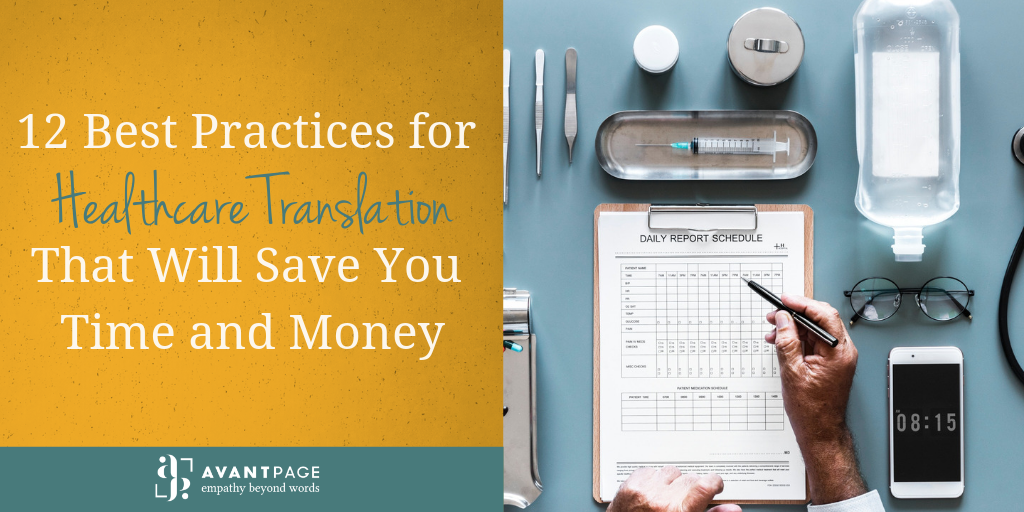If you’re new to needing translation, the entire process may seem overwhelming. There are many different documents that need to be translated, regulations to be aware of, and a wide variety of moving parts. These best practices for healthcare translation can help you maintain control of your translation projects and get you started on the right path.
Best practices for healthcare translation
1. Do An Internal-Needs Assessment
Before you find a qualified and professional Language Services Provider (LSP) for your healthcare translation needs, best practices for healthcare translation include asking some critical questions:
- What languages are you dealing with?
- What types of documents will you need to have translated?
- What file formats (Word, Excel, PDF, etc.) are the documents in?
- What regulations must you follow?
You may find that there is a particular linguistic group within your area that is not yet considered a “threshold” language. Do research to see if that population is growing and if it makes sense for your organization to provide translations in that language.
2. Allocate Appropriate Resources
Some healthcare organizations may have a cultural and linguistics department that oversees and coordinates healthcare translations, but some may not. No matter your organization’s internal structure, best practices for healthcare translation state that you will need to allocate an appropriate budget, and appoint a person or team of people to handle communications with your LSP.
3. Educate Yourself About Language Services Providers
When it comes to selecting an LSP, get well-acquainted with their translation process and quality assurance procedures, as well as the costs. Make a list of questions you need the LSP to answer, such as questions about translator qualifications and testing, data safety, and appropriate turnaround times. Any serious LSP will be excited to answer your questions, partner with you, and walk you through the process of translating your documents. This is the best way to learn about translation, create a lasting partnership, and follow best practices for healthcare translation.
4. Choose A Professional, Experienced Language Services Provider
Using bilingual employees to perform translations puts you at risk for inaccurate translations and potentially even legal action. Beyond that, having bilingual employees complete your translations takes them away from other vital projects. Hiring a professional medical translation company is one of the best practices for healthcare translation, and can help ensure accuracy and consistency.
5. Plan The Translation Process
Work with your LSP to determine your process, what steps will take place each time a document is translated, and how your specific needs will be met. Establishing a clear and detailed timeline from the beginning helps both sides move through the process smoothly. You should also be sure to note any text in a document that cannot or should not be translated for legal reasons. This will ensure that, when it comes time for translation, this text remains in the original language. Finally, in your planning, ensure that you know the written language that the document needs to be translated into. There are a variety of languages that are spoken and not written, or written and not spoken, so checking to ensure that you’re requesting translation to a written language can save you time.
6. Coordinate Translation From The Top Down
Best practices for healthcare translation state that the best way to coordinate your translations is by involving executive-level personnel. If you involve them from the beginning of your medical translation project, you can save time and frustration in the long run. Get this person, or these people, involved in your process from the very beginning and keep them informed throughout the project. This will ensure consistency throughout all documents and make for a smoother project.
7. Create Style Guides and Glossaries.
Compiled manually, style guides and glossaries will increase the overall quality and consistency of your documents. A glossary contains important terms with their preferred translations, and the style guide tells translators about linguistic and stylistic preferences, such as the audience and tone of the document. The glossary includes recurrent words/phrases that need to be translated the same way to make sense in the target language. Your LSP can help you put together these documents so you’re following best practices for healthcare translation.
8. Standardize Vital Documents
Vital documents contain information that is critical for accessing the provider or agency services and/or benefits, some examples include letters or notices that require a response from the customer or documents that inform customers of free language assistance. Vital documents can also include applications, consent forms and letters, or other template-based correspondence. A non-standard document might contain information specific to one person, to an event, or any other evolving subject matter. Standardizing your vital documents can save you time and money as you won’t have to repeat the translation projects.
9. Design And Write Documents Appropriately
Best practices for healthcare translation also include keeping your audience in mind while designing and writing your documents. If your audience reads at an elementary school level, write your documents at the same reading level and keep information as simple and clear as possible. This will also help you when it comes time to have documents translated. Documents that require certain wording for legal purposes can still be written in words everyone can understand—it may just take a little extra effort. It is important to remember that if a translation is required to be at a certain grade level, the English text should also be provided at that same level.
10. Look Ahead To Future Projects
After you’ve completed your first healthcare translation project, it will become clear how translation is more than just compliance. It’s a tool to reach new markets, keep your patients or members safe, and improve your organization’s social standing. Quality translations can be part of an investment strategy that will eventually have a major payoff.
By following this process, you can ensure a successful medical translation project. If you’d like to get started with your first healthcare translation project, call us at 530-750-2040 or request a free quote today.
GET VALUABLE CONTENT DELIVERED STRAIGHT TO YOUR INBOX. SIGN UP FOR OUR NEWSLETTER TODAY!

Ash is the Marketing Coordinator at Avantpage, Inc. Ash works to create high-value, targeted content that allows consumers to connect with us at Avantpage. They are a strong proponent of everyone having equal access to communication and information. They have written and created content for a variety of online platforms, and have been published in over 30 online platforms with varying topics. But Ash is other things too! An avid athlete, Ash enjoys spending their free time rock climbing, partaking in aerial circus sports, and practicing acroyoga.
